![]()
![]()
![]()
Use LEFT and RIGHT arrow keys to navigate between flashcards;
Use UP and DOWN arrow keys to flip the card;
H to show hint;
A reads text to speech;
208 Cards in this Set
- Front
- Back
|
Breakdown of feed into suitable products for absorption |
Digestion |
|
|
Removal of waste products from the body |
Excretion |
|
|
Casting up of undigested material |
Regurgitation |
|
|
Reduction of feed particle size, generally by chewing |
Mastication |
|
|
Nutrition provides nutrients for these functions |
Growth, work, maintenance, and repair of vital processes |
|
|
Vital proceases include these 6 things: |
1. Ingestion 2. Mastication 3. Digestion 4. Absorption 5. Metabolism 6. Excretion |
|
|
Nutrient |
Any chemical element or compound in the diet that supports normal reproduction, growth, lactation, or maintenance of life processes |
|
|
An amount of feed consumed by an animal in 24 hours (daily food supply) |
Ration |
|
|
Diet |
Feed ingredient or mixture of ingredients includino water, which is consummed by animals |
|
|
Balanced diet |
A diet that supplies all of the required nutrients in the correct proportions and amounts to properly nourish the target animal for a specific purpose of production |
|
|
Any material that is used in or made into food or feed, respectively |
Foodstuff/feedstuff |
|
|
Water is what percent of an animals weight when young and old? |
65-85% young/at birth 45-65% when older |
|
|
What are waters various functions? |
1. Transports nutrients and aids in excretion 2. Medium that allows chemical reactions 3. Body temperature regulation 4. Lubricates joints and organs in the body cavity |
|
|
Molecular weight of carbohydrates |
40% carbon 7% hydrogen 53% oxygen |
|
|
Carbohydrates include |
Sugar, starch, cellulose, and gums |
|
|
Carbohydrates serve as... |
1. Structural components in plants 2. As a source of energy and provide sufficient bulk to keep the digestive track working smoothly |
|
|
Molecular weight of lipids |
77% carbon 12% hydrogen 11% oxygen |
|
|
How much energy does 1 gram of fat yeild? How much greater is that than carbohydrates? |
1. 9.45 kcal of energy 2. 2.25 times more than carbohydrates |
|
|
Molecular weight of proteins? |
53% carbons 7% hydrogen 23% oxygen 16% nitrogen >1% sulfur and phosphorus |
|
|
Proteins serve as... |
Principle constitute of organs and soft structures of the animal body |
|
|
How many amino acids are there? |
There are 22 anime acids commonly found in proteins, 10 are required in animal diets because their body cannot synthesize them fast enough |
|
|
Minerals are... |
Inorganic, solid, crystalline elements. The total mineral content of plants or animals is often called ash |
|
|
Minerals comprise what percent of total body weight? |
3-5% of the animals dry body weight |
|
|
Essential elements required in relatively large amounts (Ca, P, Na, Cl, Mg, K) |
Macrominerals |
|
|
Microminerals |
Trace elements required in much smaller amounts |
|
|
More fats increases water holding ability in animals |
FALSE!! The more fats an animal has, the less water it holds |
|
|
Vitamins are classified by... |
Their solubility in fat |
|
|
4 Key points of vitamins are: |
1. Organic compounds of natural foods but distinct from lipids, proteins, and carbohydrates 2. Present in food in minute amounts and effective in the animal body in small amounts 3. Essential for development of normal tissue (necessary for metabolic activity) 4. When absent from the diet, results in diseases or syndromes |
|
|
Wet chemistry is also called |
Bench top methad |
|
|
Traditional laboratory methods in which chemical, drying, and burning procedures are used to determine nutrient composition |
Wet chemistry |
|
|
Near infrared reflectance |
Wet chemistry is used to calibrate NIR instruments Instruments that can detect reflectance of NIR light is used to determine nutrient composition |
|
|
Wet chemistry procedures (proximate analysis) analyze for the following: |
1. Dry matter content ( 100%-moisture content) 2. Crude protein (total nitrogen measured) 3. Ether extract (lipids and fats) |
|
|
To measure dry matter |
Heat feed sample at 100-105°C for 24 hours Loss of weight equals water 100%-water=DM% |
|
|
How to measure ash content in feed |
Place feed in a muffle furnace for 4 hours at 500°C Ash is the residue that remains Dirt can lead to high levels of ash |
|
|
Kjeldahl process uses what acid? |
Concentrated sulfuric acid |
|
|
Pros and cons of Kjeldahl process |
Pros: good precision/repeatability Cons: time consuming and can be hazardous (acid and high temps) |
|
|
Pros and cons of Dumas/Combustion method: |
Pros: less time consuming than the kjeldahl method, and not hazardous Cons: very small sample (0.1 gram sample), can be challenging to maintain |
|
|
Finding Ether extract |
Extract Ether sample for a period of 4 hours or more. The loss in weight after drying equals fat However, more than just Ether will be pulled out |
|
|
We ends analysis analyzes for |
The soluble and insoluble carbohydrates: "digestible" portion (NFE), and the less digestible portion (crude fiber) |
|
|
Nitrogen free extract equation: |
NFE=100%-(%EE+%CP+%ASH+%CF) Caculated by difference |
|
|
Detergent fiber is also called |
Van Soest Procedure |
|
|
Digested with a neutral solution |
Neutral detergent fiber Digests hemicellulose, cellulose, and lignin |
|
|
Acid detergent fiber |
Digested with an acid solution Digests cellulose and lignin |
|
|
Non-Fiber Carbohydrates are Caculated by... |
Difference |
|
|
Non-Structural Carbohydrates are... |
Determined by wet chemistry |
|
|
Steps in nutrient analysis of feeds: |
1. Dry samples down 2. Grind samples (typically a 1 mm screen) |
|
|
Ways nutrient concentrations are determined: |
1. Directly 3. Indirectly (by difference) |
|
|
When nutrients are determined by difference, what is the concern? |
Each step carries error with it (errors are additive) |
|
|
Which proximate analysis costs less money? |
NIR |
|
|
Which proximate analysis is faster? |
NIR |
|
|
Which proximate analysis is most accurate? |
Wet chemistry |
|
|
How do nutrients maintain the body? |
1. Energy needed for normal processes, activity, and warmth 2. Cells must always be replaced. The ones that line the intestine are continually being lost 3. Always lose nitrogen through metabolism |
|
|
What percent of nutrition goes toward production costs? |
40-70% |
|
|
The study of functions of the body and organs |
Physiology |
|
|
Microbes can aid in... |
Digestion and the silage making process and microbes such as fungi can grow on feedstuff and produce toxins |
|
|
The smallest amount needed to prevent a nutrient deficiency and allows physiological functions to be performed |
Requirement deification for companion animals |
|
|
Requirement definition for livestock and horses |
The smallest quantity of a nutrient that will support a targeted level of performance. This level is typically optimal growth rate, feed conversion rate, high yeild or performance |
|
|
Empirical method |
Dose-response (x-axis) Response=typically weight gain or nutrient retention (y-axis) Relationship analyzed using regression analysis |
|
|
Why is the empirical method not practical? |
It's not cost effective of practical to implement |
|
|
Factorial method: |
Nutrient requirement Caculated the sum of individual requirements for maintenence, growth, production, and reproduction |
|
|
The study of flow and transformation of energy that occurs in living organisms |
Bioenergetics |
|
|
Maintenance is a stage when... |
The body is maintained without an increase or decrease in body weight, and with no production or work being done |
|
|
Maintenence is when an animal is NOT... |
Doing nonvital work Growing Developing a fetus Storing fat Yielding any product |
|
|
Maintenence requirement is largely driven dy... |
Body weight. Increased body weight = increased maintenance requirements |
|
|
Factors affecting maintenance: |
1. Animal age 2. Production stage 3. Activity 4. Environment 5. Genetics |
|
|
Energy required to maintain vital body functions while at rest and fasting (not digesting any food) |
Basal metabolism |
|
|
Heat for maintenence of body temperature for livestock and companion animals comes from... |
1. Work of vital organs 2. Nutrient ultization (heat increment) (heat produced during digestion. Forage produces more heat, while fat produces less) 3. Normal activity |
|
|
There is a constant breakdown of body tissue protein with the by-products of breakdown being... |
Excreted largely in the urine. Protein repairs body tissue |
|
|
There is a constant loss of these, even from bones |
Minerals |
|
|
These are essential for life |
Vitamins |
|
|
Animals will die more quickly from loss of this nutrient than any other nurtient |
Water |
|
|
Essential fatty acids (2 of them) |
1. Linoleic acid 2. Linolenic acid |
|
|
Primary nurtient requirements for growth: |
Protein, water, energy, minerals, and vitamins Young animals require more protein to build muscle and grow Growth if due to an increase in muscle, bone, organs, and connective tissues |
|
|
Fattening is the deposition of... |
Unused feed energy as fat within the body tissue (abdominal or intramuscular) |
|
|
Excess feed energy can be in the form of: |
Starch, sugar, fiber, fat, or protein Protein is not fed for energy (it is very expensive) |
|
|
Fetal requirements are not considered until? |
The last trimester of pregnancy |
|
|
Nutrient requirements for milk production are Caculated based on the... |
Amount of milk produced and the concentration of a particular nutrient in the milk |
|
|
Major nutrients for milk: |
Protein and energy (can be partially met by body reserves, minerals, and vitamins) |
|
|
What mineral has the highest concentration in milk? |
Potassium |
|
|
Major increases in nutrient requirements of laying hens include: |
Protein, energy, and calcium |
|
|
Wool consists of 2 fractions: |
1. Wool fiber 2. Yolk (greasy part of wool made up of suint and lanolin) |
|
|
Wool fibers are primarily: |
Protein and high in sulfur |
|
|
Major requirement for suint |
Potassium |
|
|
Major requirement for yolk |
Energy |
|
|
What is a good science based source for information on nutrient requirements of animals? |
NRC (National Research Council) |
|
|
Taking in of feed and water into the mouth |
Prehension |
|
|
Mastication |
Reduction of feed particle size; generally by chewing |
|
|
Act of swallowing |
Deglutition |
|
|
Regurgitation |
Casting up of undigested material |
|
|
Breakdown of feed particles into suitable products for absorption |
Digestion |
|
|
Mechanical forces |
Chewing |
|
|
Acidity of the stomach (HCl 2-3) |
Chemical action |
|
|
Enzyme activity |
Hydrolysis: acts as a catalysis for a biochemical reaction |
|
|
Pre or post-gastric (cow; pre) (horse; post) |
Microbial fermentation |
|
|
Absorption |
Transfer of nutrients from the gastrointestinal tract to the circulating blood or lymph system |
|
|
Growth or building process (synthesis) |
Anabolism |
|
|
Catabolism |
Breakdown or destructive reactions (degradation) |
|
|
Combination of anabolic and catabolic reactions occurring in the body with the liberation of energy |
Metabolism |
|
|
Excretion |
Removal of wastes |
|

|
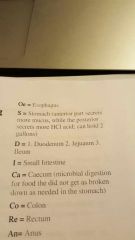
|
|
|
Carnivores |
Meat eaters Have short, simple GIT, rapid passage Rich diet that is easily digested, except for feathers, hair, and other types of resistant proteins MUST have strong protein digesting enzyme systems |
|
|
Herbivores |
Plant eaters Have long, complex GIT, slower passage through GIT, many compartments, some large for long term storage and fermentation of fiber aided by microbes |
|
|
Omnivores |
Meat and plant eaters Medium length and complexity of GIT |
|
|
Monogastrics |
These are animals such as the pig, horse (hindgut), cat, or avian, which have a single compartment stomach |
|
|
Most monogastric animals make very poor use of fibrous feeds, however one can utilize high fiber feeds. Which one, and why? |
The horse can through the use of the microbial fermentation process of the cecum and large intestine |
|
|
Ruminants |
These are animals such as the cow, sheep, goat, deer, and others that have a multi-compartment stomach |
|
|
Through the use of the microbial fermentation process of the rumen (urea, NPN, non-protein nitrogen), ruminants can: |
1. Make effective use of high fiber feeds 2. Utilize non-protein nitrogen to synthesize microbial protein 3. Synthesize B-vitamins in the rumen |
|
|
Mouth (pig) |
Proximal organ of the GIT track that contains 3 accessory organs |
|
|
3 accessory orfans to the mouth (pig) |
1. Tongue 2. Teeth 3. Salivary glands |
|
|
Tongue (pig) |
Prehension, mixing, deglutition |
|
|
Teeth (pig) |
Prehension and mastication |
|
|
Salivary glands (pig) |
2 paired glands that secrete fluid called saliva |
|
|
Components of saliva (pig): |
Water: moisten consumed feed and aids in taste mechanisms Mucin: lubrication help/aid in deglutition Inorganic salts: in form of bicarbonate which acts as a buffer to regulate the pH (8.2 in the stomach of the pig) of the stomach Amylase: (not in all species) initiates carbohydrate breakdown (typically breaks down starch) |
|
|
A hallow muscular tune that transports ingests from the mouth to the stomach (pig) |
Esophagus Ingesta material in moved by a wave of contractions (referred to as the peristaltic waves or peristalisis) |
|
|
Stomach (pig) |
A hallow, pear-shaped muscular digestive organ |
|
|
Functions of the stomach (pig) |
1. Storage 2. Muscular contractions 3. Secretions |
|
|
Ingested feed is stored temporarily in the form of chime (thick semifluid mass) - partially digested contents |
(Pig stomach) Storage |
|
|
Muscular contractions (pig stomach) |
Regular contractions of muscular walls cause movement and mixing of chyme |
|
|
Secretions in the pig stomach are various digestive juices that are secreted and include: |
1. Hydrochloric acid: lowers pH to ~2 which is ideal for the enzymes in the stomach 2. Mucus: covers the entire stomach to protect it 3. Pepsin: a protease enzyme that hydrolyzed or Digests protein 4. Rennin: a pretense enzyme that converts (milk casein to curdled/coagulated casin) |
|
|
Why is the stomach acidic? |
1. Kills bacteria 2. Breaks down or Digests some food components and makes protein more susceptible to enzymatic digestion 3. Activates pepsinogen (zymogen) conversion to pepsin 4. Provides the proper environment for the pepsin to work 5. Of chyme that leaves the stomach and enters the small intestine stimulates the various secretions from the small intestine |
|
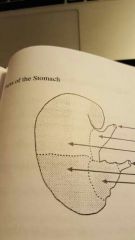
|
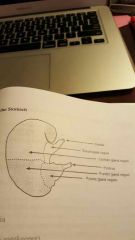
|
|
|
Cardiac sphincter |
Located at the Junction of the esophagus and the stomach that controls passage of Ingesta into the stomach or out |
|
|
Nonglandular area surrounding the cardia |
Esophageal region |
|
|
Cardiac gland region |
Contains cells that produce primarily mucus (protects the stomach lining) |
|
|
Contains cells that provide the gastric secretions needed for the initial stages of digestion |
Funding gland region |
|
|
The fundic gland region contains 2 types of cells: |
1. Parietal cells: produce HCl 2. Chief cells: produce enzymes or precursors of enzymes |
|
|
Pylori gland region |
Contains cells that produce mucus and some proteolytic enzymes |
|
|
Beginning for the small intestine |
Pylorus |
|
|
Pyloric sphincter |
Located at pylorus which controls passage of chyme out of the stomach |
|
|
Small intestine (pig) |
A long narrow tune that is the most active digestion and nutrient absorption site |
|
|
The pigs small intestine is divided into 3 sections: |
1. Duodenum: site of active enzyme secretions from the Duodenum and pancreas. Bile enters from the gall bladder/liver 2. Jejunum: middle section, active in nutrient absorption 3. Ileum: active in nutrient absorption, pH ~6-7 |
|
|
Liver (pig) |
Bile is produced by the liver, and stored in the gall bladder, and is comprised mainly of water and alkaline salts to counter the acidity of HCl |
|
|
Pancreas |
Pancreatic juice is secreted by the pancreas into the Duodenum through the Pancreatic duct |
|
|
Components of pancreas juice: |
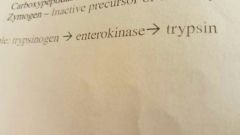
Water, and alkaline as well as proteolytic enzymes: Trypsin: aids in protein digestion Chymotrypsin: aids in protein digestion Carboxypeptidases: aids in protein digestion Zymogen: inactive precursor of the enzyme |
|
|
Amylase |
Breaks down starch - attacks alpha 1,4 glucan links in starch and glycogen |
|
|
Amylase |
Breaks down starch - attacks alpha 1,4 glucan links in starch and glycogen |
|
|
Lipase |
Digest fats Triglycerol 》 monoacylglycerol |
|
|
The intestinal wall is composed of: |
1. Water 2. Alkaline (neutralizes) 3. Carbohydrates (catalyze final steps of the carbohydrate digestion) |
|
|
The villi of the intestinal wall produce |
Disaccharidases |
|
|
Sucrase Digests Sucrose into |
Glucose and fructose |
|
|
Lactase Digests lactose into |
Glucose and galactose |
|
|
Maltase Digests maltose into |
Glucose and glucose |
|
|
What are the 2 functions of aminopeptidases and dipeptidases? |
1. Catalyze the final steps of protein digestion 2. Work on intermediates from protein digestion |
|
|
Enterokinase converts trypsinogen to |
Trypsin (zymogen) |
|
|
Perisyalsis |
Contractions of the smooth intestinal muscles, stimulated by the presence of Ingesta, especially fiber |
|
|
Active absorption |
Requires energy and can occur against a concentration gradient |
|
|
Passive absorption |
Movement of materials across cell membrane by simple diffusion: automatically by physical principles |
|
|
Surface area |
Lumen |
|
|
The walls of the small intestine are lined with a series of finger-like projections called... |
Villi |
|
|
Villi house minute projections called |
Microvilli Microvilli increase the nutrient absorption area |
|
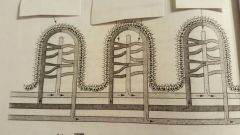
|
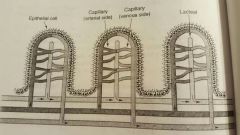
|
|
|
Most nutrients are absorbed into the... |
Blood Most nutrients are absorbed into the blood. Lipids are absorbed into the lymphatic system, then the blood |
|
|
Most absorption takes place in the... |
Small intestine |
|
|
What is usually the only substance left (for absorbance) in the large intestine? |
Fiber |
|
|
What are the 3 sections that the large intestine is divided into? |
1. Cecum: 1st section, little importance in the pig 2. Colon: larfest part of the large intestine 3. Rectum: last section |
|
|
3 functions of the large intestine? |
1. Site of water reabsorption 2. Secretion of some mineral elements 3. Storage reservoir of undigested GIT contents |
|
|
Functions of bacterial fermentation in the large intestine? |
1. Synthesis of water-soluble vitamins and vitamin k 2. Some breakdown of fiber that remains in the GIT 3. Synthesis of protein |
|
|
There are no villi in the large intestine so... |
Limited absorption of nutrients from feedstuff from microbial origin |
|
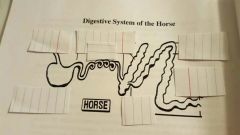
|

|
|
|
4 differences from the horse digestive system and the pig: |
1. Saliva contains no enzymes 2. Never vomits 3.no gal bladder (enzymes produced by bacteria) 4. Greatly enlarged large intestine |
|
|
Mouth of the horse (3 items) |
1. Prehensive agents are: teeth, upper lip, and tongue 2. Upper jaw is wider than lower jaw 3. Saliva contains no enzymes |
|
|
Esophagus of the horse (2 items) |
1. 50-60 inch long tube on the left side of the neck 2. Peristaltic movement only goes down |
|
|
Stomach of the horse (2 items) |
1. Compared to other species, the horse has a much smaller stomach 2. The stomach does not have extensive muscular movement activity like other species (Ingesta arranges itself in layers, needs several small portions per day, greater chance of digestive disorders) |
|
|
Compared to the small intestine in the pig, the horse does not have a... |
Gall bladder |
|
|
The bacteria in the large intestine of the horse can (3 items): |
1. Breakdown cellulose and other carbohydrates 2. Synthesize water soluble vitamins 3. Synthesize proteins (some absorption of volatile fatty acids occurs in the cecum) |
|
|
5 parts and functions of the large intestine in the horse: |
1. Accounts for over 60% of the GIT track 2. Divided into: cecum, large colon, small colon, and rectum 3. Cecum and colon contain active microbial populations similar to that of the rumen 4. Small colon: primary area for water absorption from intestinal contents) 5. Impaction can easily occur |
|
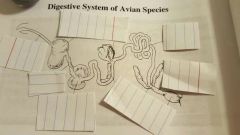
|
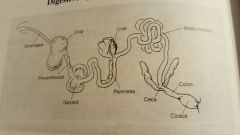
|
|
|
The chicken has a rigid and attached tongue and poorly developed salivary glands, but no... |
Teeth |
|
|
The chicken has a beak that is adapted for... |
Rapidly picking up small particles and reduces food particle size |
|
|
The saliva of the chicken contains... |
Salivary amylase |
|
|
An enlarged area of the esophagus |
Crop |
|
|
3 functions of the crop: |
1. Serves as an Ingesta holding and moistening reservoir, and slows the rate of food passage 2. Allows breakdown of salivary amylase 3. Some microbial activity so that fermentation occurs in some species |
|
|
Proventriculus (glandular secretory site) performs: |
1. Gastric juice production (pH~4) 2. Ingesta passage is rapid (~14 seconds) |
|
|
3 functions of the gizzard: |
1. Thick muscular walled area acting to reduce particle size 2. Contains grit that aids in grinding of ingested seeds and grains 3. No secretions of enzymes (HCl and pepsin from proventriculus work in gizzard) |
|
|
Small intestine of avian |
Slightly acidic |
|
|
Differences in the chickens small intestine from the pig (4 differences): |
1. Bile and pancreatic ducts enter the small intestine near the end of the Duodenum 2. No lactase 3. Villi contain no lateals (fat absorbed directly into the blood) 4. The hormone estrogen is not present in birds |
|
|
Differences in the ceca and colon in avain compared to the pig (3 differences): |
1. Chicken have 2 ceca compared to the mammals 1 2. The colon in chicken is very short (2-4 inches) 3. Feces and urine are excreted together (birds produce uric acid; mammals produce urea) |
|
|
What are the 2 functions of the ceca and colon: |
1. Water reabsorption 2. Some fiber digestion and water-soluble vitamin synthesis occurs in ceca because of bacterial fermentation (much lower levels than mammals) |
|
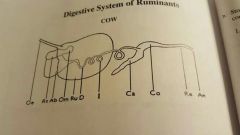
|
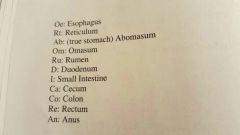
|
|
|
The cows mouth has 3 items: |
1. No upper incisor, instead a dental pad 2. Molar teeth (upper and lower) 3. Saliva production is relatively continuous (50 gallons a day for cow; 2 gallons or more for sheep) (no enzymes but provide urea (N) and P and Na microbes; highly buffered) |
|
|
Esophagus opening is common to both the reticulum and rumen compartments |
Stomach |
|
|
Reticulum (honeycomb) |
It's all are lined with mucus membranes containing many intersecting ridges that subdivided with the surface into honeycomb like compartments |
|
|
What are the 3 functions of the reticulum? |
1. Wall arrangement traps hardware (nails, wire, etc...) 2. Walls secrete no enzymes 3. Functions in moving ingested feed into the rumen or into the omasum and in regurgitation of Ingesta during rumination |
|
|
A large muscular compartment that almost entirely fills the left side of the abdominal cavity. The walls of the ??? Contain projections called papillae. Walls secrete no ednzymes |
Rumen |
|
|
Functions of the rumen (4 functions) |
1. Storage 2. Soaking 3. Physical mixing and breakdown 4. Fermentation chamber (moist, warm (39°C), anaerobic (little oxygen), desirable pH (5.5-6-5), and there is a continual infusion of substrate and removal of end products in digestion) |
|
|
Pregastric fermentation consists of (3 items): |
1. Bacterial synthesis of water soluble vitamins and vitamin k 2. Bacterial synthesis of amino acids and proteins 3. Breakdown of fibrous feeds (high in cellulose) |
|
|
Omasum |
A spherical organ filled with muscular laminae (leaf-like structure). Walls secrete no enzymes |
|
|
Function of the omasum: |
Reduce the particle size of Ingesta before it enters the abomasum; absorption of water |
|
|
The first glandular portion of the ruminant GIT. Walls secrete enzymes |
Abomasum ("true" or glandular stomach) |
|
|
The small and large intestine of the cow are most similar in structure and function to the... |
Pig |
|
|
A passageway that extends from the cardia to the omasum, which can close to direct Ingesta from the ??? Into the omasum directly, or open and permit Ingesta to enter the rumen/reticulum |
Esophageal (reticular groove) |
|
|
Function of the reticular groove. |
To allow milk to bypass the reticulum and escape bacterial fermentation |
|
|
Rumination |
A process that allows an animal to ingest feed rapidly, then complete the chewing at a later time |
|
|
What are the 4 steps of rumination? |
1. Regurgitation 2. Remastication 3. Resalivation 4. Reswallowing |
|
|
How many hours do cattle average ruminating? How much time does 1 rumination cycle require? |
1. ~8 hours a day 2. 1 minute, 3-4 seconds is utilized for both regurgitation and reswallowing |
|
|
Belching of gas |
Eructation |
|
|
What are the gasses that are commonly built up in cattle? What happens if the gas is not released? |
1. CO2 and CH4 2. Bloat. A froth or foam is produced in the rumen which interferes with normal belching |
|
|
Does a post- (horse) or pre-gastric (ruminant) animal have and advantage with starch? |
Advantage to horse, ruminant less effecient |
|
|
Does a post-gastric (horse) or pre-gastric (ruminant) animal have more of an advantage with fiber? |
Adean take to ruminant. Total fermentation is greater in the rumen compared with the hindgut of the horse |
|
|
Which animal is diatrey protein quality more important? |
Horse |
|
|
Proteins in the rumen |
Microbes (lysine and methiamine; very high in microbes) (synthesize protein;very high in quality) in the rumen alter the dietary protein |
|
|
2 functions of vitamins in the rumen |
1. Vitamins produced by microbes in the rumen are avaible for absorption in the small intestine (in the horse they are not) 2. B-vitamin supplementation in the diet is less important for ruminants |
|
|
What do fats become in the rumen? |
They become biohydrogination saturated by microbes |
|
|
What 2 species do not have salivary amylase? |
Ruminant and horse |
|
|
Pepsin |
Protein to polypeptides |
|
|
Rennin |
Milk curdling or protein denatureation |
|
|
Lipase |
Fat splitting; minor activity compared with pancreatic digestion |
|
|
You cannot absorb proteins form... |
Peptides |

